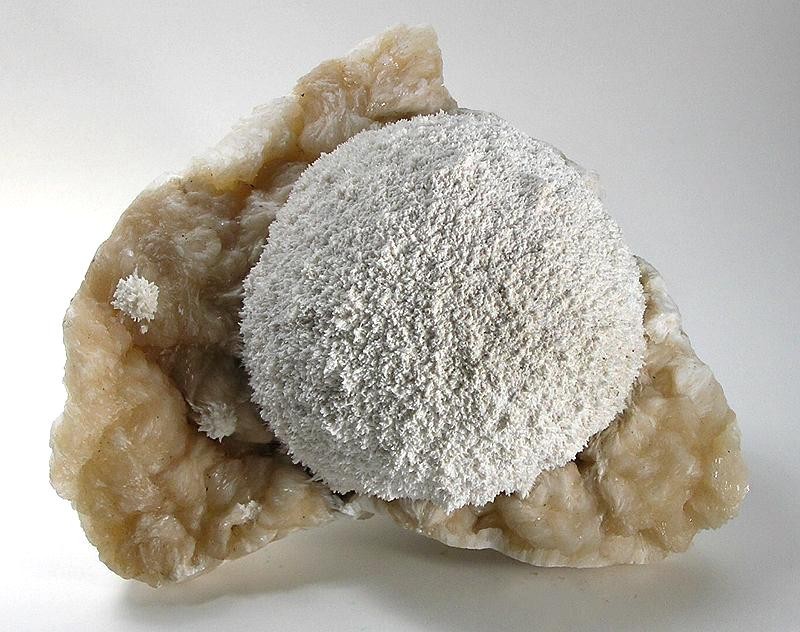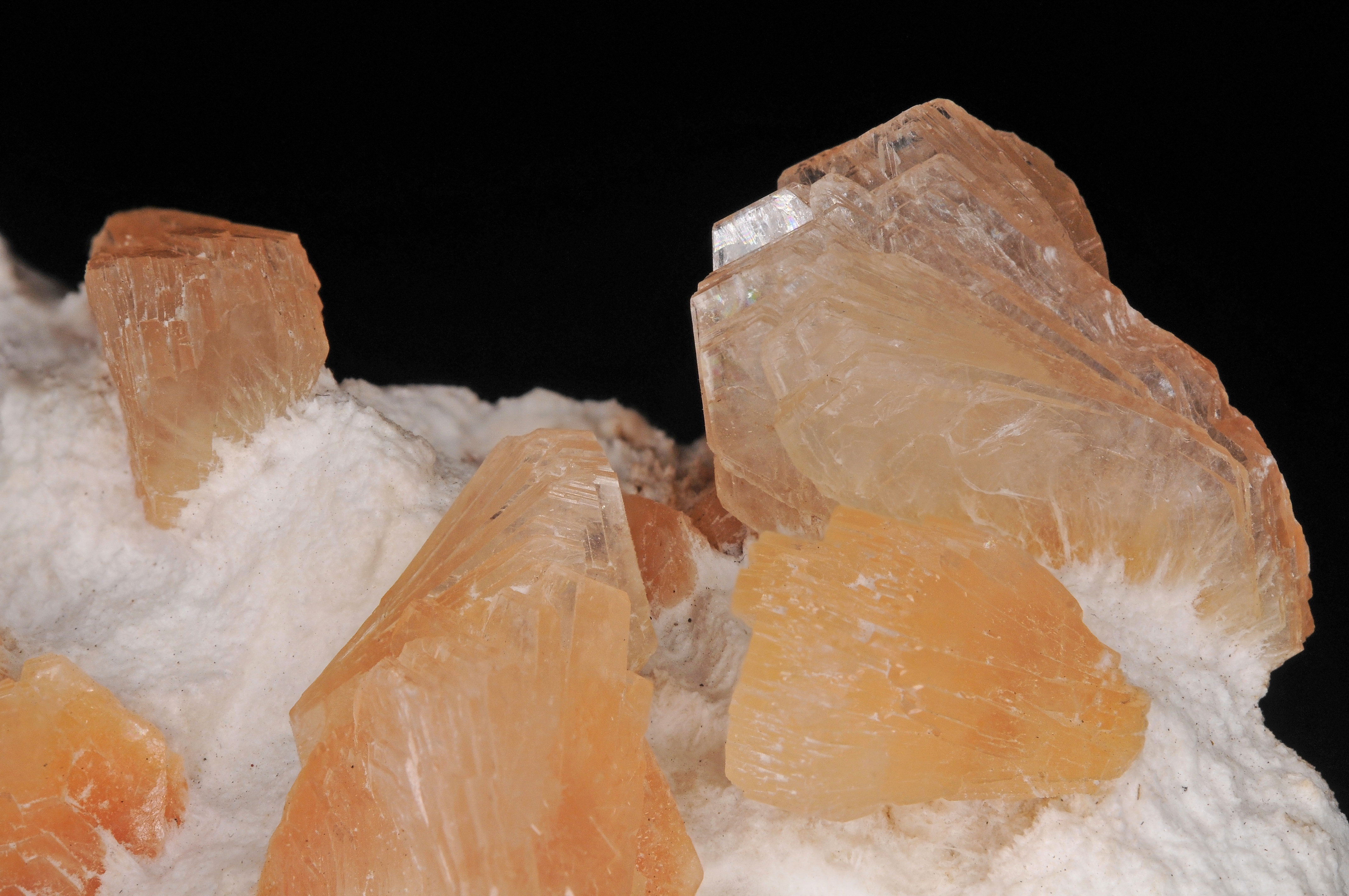
Mordenite Gemstone: Properties, Meanings, Value & More
 Mordenite is an abundant zeolite mineral sometimes used as a gemstone but more frequently used commercially. This commonly white or colorless stone often has a fibrous structure that can cause the “cat’s eye” effect.
Mordenite is an abundant zeolite mineral sometimes used as a gemstone but more frequently used commercially. This commonly white or colorless stone often has a fibrous structure that can cause the “cat’s eye” effect.
In terms of rarity, the mineral itself is one of the most common zeolites, but gemstones are pretty uncommon.
Is mordenite a natural zeolite? Yep, mordenite is natural, though many industrial uses for mordenite favor synthetic mordenite.
We’ll tell you all about mordenite’s uses, properties, history, prices, and more in this guide!
 Pictured above: Mordenite geode | Image credit: Rob Lavinsky, iRocks.com – CC-BY-SA-3.0
Pictured above: Mordenite geode | Image credit: Rob Lavinsky, iRocks.com – CC-BY-SA-3.0
About Mordenite Stone
Mordenite is an uncommon semi-precious gemstone that’s naturally white or colorless, but sometimes stained other hues. Previous monikers for the stone include:
Arduinite
Ashtonite
Steelite
Ptilolite
Pseudonatrolite
“Pseudonatrolite” is a bit of a misnomer, but mordenite and natrolite are both commercially important zeolites.
On that note, what is mordenite used for?
Mordenite Uses
Like many zeolites, mordenite is largely known for its industrial and commercial uses. Most mordenites used industrially are synthetic, since they’re more pure than natural material.
Some of mordenite’s valuable traits include strong acidity, high stability both thermally and chemically, and large pore size.
Mordenite is often used as a:
Catalyst: Increases chemical reaction rate; Usually in petrochemical industry
Adsorbent: Attracts substances to its surface, like chemical or oil spills
Molecular Sieve: Separates molecules by size of its pores; Used in petroleum industry for cracking (breaking up molecule chains), chemical labs for drying solvents, and air supply filtration
Desiccant: Drying agent for ethanol fuel, medicine containers, food additive (anti-caking), electronic component packaging, and perishable chemical packaging
Dimension Stone: Decorative or structural stone used in agricultural and construction industries
Scientists have also synthesized mordenite for mineralogical research.
 Pictured above: Mordenite ball on stilbite crystals | Image credit: Rob Lavinsky, iRocks.com – CC-BY-SA-3.0
Pictured above: Mordenite ball on stilbite crystals | Image credit: Rob Lavinsky, iRocks.com – CC-BY-SA-3.0
Mordenite Specifications & Characteristics
First, what is mordenite made of? Mordenite is a hydrated sodium, potassium, calcium aluminosilicate. The mineral’s formula may be written as (Ca,Na2,K2)Al2Si10O24·7H2O or (Na2,Ca,K2)4(Al8Si40)O96·28H2O, the latter approved by the International Mineralogical Association (IMA). Magnesium is a common impurity.
The composition having a high silicon-aluminum ratio makes mordenite more valuable industrially, since it’s harder for acids to attack it.
Mordenite is a zeolite variety. Other well-known zeolites include thomsonite, natrolite, chabazite, and stilbite, to name a few.
Crystals can be prismatic and vertically striated or long, thin, and needle-like. The mineral also occurs as compact masses, radiating crystal clusters (usually needles), or aggregates that can be cotton-like, reniform, porcelaneous, or fibrous.
On a molecular level, mordenite’s structure is a framework with chains of silicate and aluminate tetrahedra on five-membered rings.
Mordenite properties listed:
Mohs hardness: 4-5
Color: Colorless, white, pale yellow, pale pink
Crystal structure: Orthorhombic
Luster: Vitreous or silky; Pearly on {010}
Transparency: Transparent to translucent
Refractive index: 1.472-1.487
Density: 2.12-2.15
Cleavage: Perfect on {100}, Distinct/good on {010}
Fracture: Conchoidal or irregular/uneven
Streak: White
Luminescence: None
Pleochroism: None
Birefringence: 0.005
Dispersion: None
Optical phenomena: Chatoyancy
Moving away from mineralogy, what is the spiritual meaning of mordenite?
 Pictured above: White mordenite balls on gray quartz vug | Image credit: Rob Lavinsky, iRocks.com – CC-BY-SA-3.0
Pictured above: White mordenite balls on gray quartz vug | Image credit: Rob Lavinsky, iRocks.com – CC-BY-SA-3.0
Mordenite Meaning & History
Mordenite crystals symbolize abundance, renewal, peace, and clarity.
Many occult practitioners use mordenite in white magic rituals. White magic is sometimes called “protective” or “high magic,” and is characterized by good intentions of helping, benefitting, or healing other people or objects.
History
The earliest known evidence of mordenite is a chert bead containing mordenite, cristobalite, and quartz. Discovered around 2000 on the Antigua island, the bead dates to around 250-500 AD in a site thought to have been jewelry manufacturing centers during that period.
Mordenite’s name comes from where it was first discovered: the community of Morden in Nova Scotia, Canada. British-Canadian chemist, geologist, and mineralogist Henry How made this discovery, named the mineral mordenite, and published the first description in 1864.
Confusion with “Ptilolite”
In 1886, American geologist and petrologist Charles Whitman Cross and L.G. Eakins reported a supposedly new mineral from Jefferson County, Colorado, USA. They called it “ptilolite” from the Greek term pylon, meaning “feather” after its feather-like appearance.
Their description of ptilolite: “new hydrous silicate of alumina, lime [calcium oxide] and alkalies [potassium oxide and sodium oxide].” They soon found another occurrence in Custer County, Colorado.
In 1892, Cross and Eakins pointed out that mordenite and ptilolite have the same empirical formulas but are “physically very unlike.”
However, American chemist Frank Wigglesworth Clarke published a note in the same issue of The American Journal of Science in 1892 stating that “Both ptilolite and mordenite become simply representable by the same general formula.”
Though some publications still called the mineral “ptilolite,” like Waldemar T. Schaller’s report on “ptilolite” from Utah in 1932, this name has since become a synonym for mordenite.
First Synthetic Mordenite
In 1948, New Zealand-born chemist Richard Maling Barrer (nicknamed the “Founding Father of Zeolite Chemistry”) created the first synthetic zeolite with no natural counterpart and the first synthetic mordenite.
 Pictured above: Heulandite crystals on mordenite specimen | Image credit: Parent Géry, CC-BY-SA-3.0
Pictured above: Heulandite crystals on mordenite specimen | Image credit: Parent Géry, CC-BY-SA-3.0
Mordenite Healing Properties
As a primarily white or colorless healing stone, mordenite benefits reflect those of other white gemstones, attracting abundance, peace, and cleansing. Mordenite can be used with other crystals to enhance its healing powers.
If you practice energy healing, mordenite is a powerful chakra stone for balancing the crown chakra, your highest, most spiritual energy center.
Many crystal healers use mordenite on green apophyllite specimens, bringing in the rejuvenating, prosperous, and joyful energies of green gemstones. Another popular option is cavansite on mordenite, which is said to bring peace during times of stress.
What are the benefits of mordenite physically?
Physical Healing
Physically, mordenite is said to help with issues related to the lungs, mouth, and throat.
Emotional Healing
Emotionally, mordenite is believed to:
Quiet restless thoughts
Ease depression
Improve concentration
Attract abundance
Dispel negativity
Balance emotions
Alter your perspective for the better
Mordenite Gemstone Properties
Since mordenite gems are quite uncommon, there isn’t standard grading for them. We’ll still go over how the standard value factors apply to mordenite, though:
Color: While colorless or white specimens are most common, they can be stained pale pink or yellow.
Cut: You might find some faceted mordenites, but they’re likely combinations of mordenite and other minerals. Most cut specimens are made for collectors. Chatoyant mordenite must be cut into cabochons to display this effect. Most mordenite for sale is rough (uncut).
Carat Weight & Size: Rough can be quite large, but most cabochons are cut from nodules up to around 1 inch.
Speaking of rough, how does mordenite form?
 Pictured above: Peach-colored heulandite and white calcite crystals on mordenite | Image credit: Rob Lavinsky, iRocks.com – CC-BY-SA-3.0
Pictured above: Peach-colored heulandite and white calcite crystals on mordenite | Image credit: Rob Lavinsky, iRocks.com – CC-BY-SA-3.0
Mordenite Formation & Sources
Mordenite typically forms as an alteration product of sedimentary rocks, lava flows, or pyroclastic sediment. It can even form when volcanic natural glass is altered by water.
The stone is mostly found in altered volcanic deposits and lava rocks like basalt, andesite, and rhyolite. Mordenite has also been found in marine sediments
Mining Locations
Where is mordenite mined? Some significant mordenite crystal sources are:
Bulgaria
Canada
Denmark
England
Hungary
Iceland
Italy
India
Japan
New Zealand
Norway
Russia
Scotland
USA (California, Colorado, Idaho, New Jersey, Oregon, Utah, Washington, Wyoming)
Sources aside, how much does mordenite cost?
Mordenite Price & Value
As mentioned, mordenite is mostly sold as rough specimens. However, you can find faceted gems of mordenite combined with other stones.
These faceted gems go for around $25 to $50 per carat.
Most rough mordenite specimens are combined with minerals like apophyllite, stilbite, chalcedony, or heulandite. On the low end, you can find small specimens for around $5 to $25.
On the higher end are huge, unique specimens costing $500 to $12,000, some reaching $27,000.
Cabochons and cabochon pendants are generally around $30 to $35.
 Pictured above: White mordenite balls on amethyst pocket | Image credit: Rob Lavinsky, iRocks.com – CC-BY-SA-3.0
Pictured above: White mordenite balls on amethyst pocket | Image credit: Rob Lavinsky, iRocks.com – CC-BY-SA-3.0
Mordenite Care and Maintenance
First, is mordenite zeolite safe? It depends. Fibrous mordenite can pose risks if you inhale or ingest the fibers, so be cautious and take precautions when handling (and especially if cutting) these rough specimens.
In terms of gemstone care, we recommend opting for protective settings for any mordenite jewelry.
You can clean mordenite with warm water, mild soap, and a soft toothbrush. Store it separately from other gems to avoid scratches.
Want More of Mordenite?
A lesser-known crystal in the gemstone realm, mordenite is a valuable stone beyond its commercial uses. Its uplifting, rejuvenating energies are a great refresh and its neutral color will match any space.
Search the Gemstone Encyclopedia
Related Auctions
Related Articles
Originally the Birthstones or gemstones were associated with a zodiac sign or the month of a individuals birth. Find out what your stone is and view the stones we have for sale
8th Feb 2021
There are dozens of quartz and chalcedony gems with various colors and patterns. Learn all about quartz properties and every type of quartz, from amethyst and agate to plasma and phantom quartz!
15th Oct 2020
Hackmanite is a pink to violet sodalite gem known for its unique color-change and luminescence. Learn why hackmanite is special, from its rare qualities to the types of hackmanite jewelry available.
28th Mar 2018
Latest Articles
Catapleiite is a lesser-known mineral and rare gemstone often found as stunning tabular rosettes near other rare stones. Discover the history, prices, benefits, and properties of catapleiite!
28th Apr 2025
Yugawaralite is a rare colorless, white, or pinkish zeolite crystal named for its discovery in Yugawara, Japan. Here we uncover the multifaceted history, properties, prices, and uses of yugawaralite.
24th Mar 2025
Simpsonite is a lesser-known mineral known on the gem market for its durability, yellow-orange color, and rarity. Discover all the properties, uses, prices, and history of simpsonite.
3rd Mar 2025
Article Categories
How To's is where you will find helpful articles from gem Rock Auctions on how to cut gemstones, select gemstones and buy gemstones.
9 Articles




